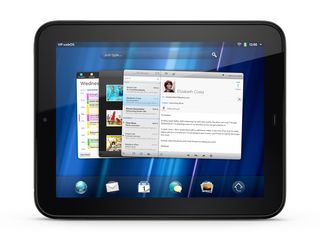Why you can trust TechRadar

The HP TouchPad has been eagerly awaited, so the question is whether it was worth it. The iPad's already on its second iteration, while Samsung has been fine-tuning the template it laid down late last year with the original Galaxy Tab and turning it into the Galaxy Tab 10.1. And Asus' Eee Pad Transformer just about blew us away, doing something really different.
Where does the TouchPad sit among these? It's got an appealing design, a revered operating system and enviable specs, but the challenge for many early attempts has been to create something that's more than the sum of its parts.
We liked
HP webOS is a genuinely impressive operating system. Although some tout it as being intuitive, we're not sure that's really its strength. With its multitasking and the way its cards and stacking features work, it can be a great working tool, grouping apps together by task.
The design of the TouchPad on the whole is nice, even if it's got some downsides. It's all nicely featureful, with plenty of social network integration being supplemented by the likes of 1080p video playback and Adobe Flash support. Other usability tweaks, such as the resizable keyboard, are very handy too.
The integration with other HP/Palm products is also a thoughtful touch. We didn't have a Pre 3 to test the touch-sharing technology or messaging/call sharing, but these are great little technological touches that should appeal to the webOS purists.
HP Pivot is also a really strong feature. Turning app discovery into an editorial experience is a great way to differentiate the AppCatalog from its equivalents on iOS or Android.
We disliked
The reason the HP TouchPad hasn't got a higher score overall isn't due to some major flaw or missing feature. It's more of a 'death by 1,000 paper cuts' situation (although 'death' is a major exaggeration).
Performance is sluggish. It's not as bad as the worst budget tablets around, certainly, and not all of the time, but it's often enough that it doesn't come across that well for its price point.
The AppCatalog just isn't as fully stocked as its rivals. The most impressive apps are multi-platform, so the TouchPad struggles to stand out from this perspective.
There's 1080p movie playback, but no HDMI out to enjoy it. Similarly, the screen has fairly good viewing angles and is nice enough when viewed in isolation, but doesn't go as bright as its rivals, and just isn't as good under lights because of it.
The notification system is impressively unobtrusive, but isn't a lot of good for getting information at a glance. The video player didn't pull through thumbnails or names. The music player couldn't decide if it should show album art or not.
None of these is a deal breaker on its own, but they – and myriad other small niggles – add up to create an experience that feels more unpolished the more you use it.
Verdict
Imagine the current crop of tablets side by side in a shop. Someone walks along and the question is "Why would I buy this one over the others?"
The HP TouchPad is less polished than the iPad, with a smaller range of impressive third-party apps. Yes, it's got features that the iPad lacks, but so do the Android tablets, and they have a bigger app selection, too. The interface appears more polished than many Android tablets, but in operation that doesn't really stand up. It's also lagging behind in many hardware features, such as HDMI output.
HP webOS is a very well thought-out operating system, and there's a lot to like about the TouchPad. But why would you buy it over the others? We're not sure many people will find an answer to that question.

